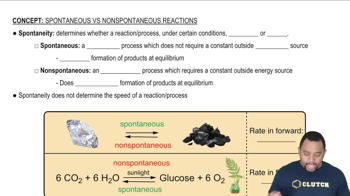Calculate the change in Gibbs free energy for each of the sets of ΔHrxn, ΔSrxn, and T given in Problem 42. Predict whether or not each reaction is spontaneous at the temperature indicated. (Assume that all reactants and products are in their standard states.)
Ch.18 - Free Energy and Thermodynamics
Chapter 18, Problem 46
Calculate the free energy change for this reaction at 25 °C. Is the reaction spontaneous? (Assume that all reactants and products are in their standard states.) 2 Ca(s) + O2( g) → 2 CaO(s) ΔH°rxn = -1269.8 kJ; ΔS°rxn = -364.6 J/K
 Verified step by step guidance
Verified step by step guidance1
Identify the formula for calculating the Gibbs free energy change: \( \Delta G^\circ = \Delta H^\circ - T \Delta S^\circ \).
Convert the temperature from Celsius to Kelvin: \( T = 25 + 273.15 = 298.15 \text{ K} \).
Ensure that the units for \( \Delta S^\circ \) are consistent with \( \Delta H^\circ \). Convert \( \Delta S^\circ \) from J/K to kJ/K by dividing by 1000: \( \Delta S^\circ = -364.6 \text{ J/K} = -0.3646 \text{ kJ/K} \).
Substitute the values into the Gibbs free energy equation: \( \Delta G^\circ = -1269.8 \text{ kJ} - (298.15 \text{ K} \times -0.3646 \text{ kJ/K}) \).
Determine if the reaction is spontaneous by checking the sign of \( \Delta G^\circ \). If \( \Delta G^\circ < 0 \), the reaction is spontaneous.

Verified video answer for a similar problem:
This video solution was recommended by our tutors as helpful for the problem above.
Was this helpful?
Key Concepts
Here are the essential concepts you must grasp in order to answer the question correctly.
Gibbs Free Energy
Gibbs Free Energy (G) is a thermodynamic potential that measures the maximum reversible work obtainable from a thermodynamic system at constant temperature and pressure. The change in Gibbs Free Energy (ΔG) for a reaction can be calculated using the equation ΔG = ΔH - TΔS, where ΔH is the change in enthalpy, T is the temperature in Kelvin, and ΔS is the change in entropy. A negative ΔG indicates that a reaction is spontaneous under the given conditions.
Recommended video:
Guided course

Gibbs Free Energy of Reactions
Standard State Conditions
Standard state conditions refer to a set of specific conditions used to measure the properties of substances, typically defined as 1 bar of pressure and a specified temperature, usually 25 °C (298 K). Under these conditions, the standard enthalpy (ΔH°) and standard entropy (ΔS°) values are determined for reactants and products. These values are essential for calculating the Gibbs Free Energy change for reactions, as they provide a reference point for the thermodynamic properties.
Recommended video:
Guided course

Standard Reduction Potentials
Spontaneity of Reactions
The spontaneity of a reaction refers to whether a reaction can occur without external intervention. A reaction is considered spontaneous if it leads to a decrease in free energy (ΔG < 0). Factors influencing spontaneity include enthalpy (ΔH) and entropy (ΔS) changes; a reaction can be spontaneous at certain temperatures even if it is endothermic (positive ΔH) if the entropy increase (positive ΔS) is sufficiently large to make ΔG negative.
Recommended video:
Guided course

Spontaneity of Processes
Related Practice
Textbook Question
Textbook Question
Calculate the free energy change for this reaction at 25 °C. Is the reaction spontaneous? (Assume that all reactants and products are in their standard states.) C3H8(g) + 5 O2(g) → 3 CO2(g) + 4 H2O(g) ΔH°rxn = -2217 kJ; ΔS°rxn = 101.1 J/K
Textbook Question
Fill in the blanks in the table. Both ΔH and ΔS refer to the system.
Textbook Question
Predict the conditions (high temperature, low temperature, all temperatures, or no temperatures) under which each reaction is spontaneous. a. H2O(g) → H2O(l) b. CO2(s) → CO2(g) c. H2(g) → 2 H(g) d. 2 NO2(g) → 2 NO(g) + O2(g) (endothermic)
Textbook Question
How does the molar entropy of a substance change with increasing temperature?
